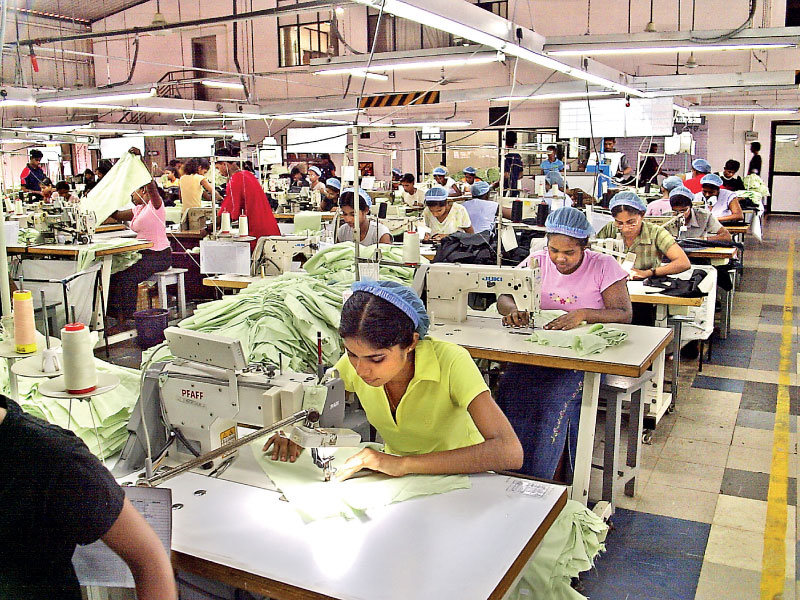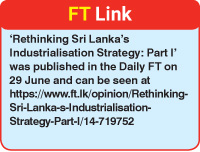Monday Dec 15, 2025
Monday Dec 15, 2025
Wednesday, 30 June 2021 00:00 - - {{hitsCtrl.values.hits}}

Following the 1977 policy reforms, the export structure of the economy has undergone a remarkable shift from the traditional ‘primary trio’ (tea, rubber and coconut products) to labour-intensive manufacturing
 Manufacturing performance
Manufacturing performance
Growth of manufacturing in the Sri Lankan economy, as reflected in the national accounts, was lacklustre during the State-led import substitution era. In the 1960s, at the early stage of import-substitution industrialisation (ISI), the average annual manufacturing growth rate was around 8.5%, but it propped to a mere 3% in 1970-76. By that time, unanticipated curtailment of imported intermediate inputs brought about by foreign exchange scarcity, had become a binding constraint on industrial expansion.
The manufacturing sector entered a distinct growth phase following the liberalisation reforms. Contrary to the gloomy predictions by the critics of reforms, the lifting of import controls did not result is a sudden massive contraction. Free availability of imported inputs and capital goods in the liberalised economy, the cushioning effect against import competition provided by moderate tariffs, and the exchange rate depreciation help domestic manufacturing to face import completions, although there was some business failures (in particular virtual disappearance of the handloom industry). Following initial adjustments to the new competitive market setting, manufacturing growth surpassed that of other sectors during most years during the next two decades.
From the late 1970s to about the late 1990s, manufacturing grew at an average annual rate of about 6.5%, compared to an overall GDP growth rate of 5.3%. The manufacturing share of GDP therefore recorded an almost two fold increased, from 10% to nearly 20% by the early 2000s. Since then the trend has reversed, reflecting the faster growth the non-tradable sectors propelled by the post-civil war construction boon and the slowing of manufacturing growth. The share of manufacturing in GDP declined from 19% in the early 2000s to 15% in 2019.
The expansion of the manufacturing sector has also been underpinned by a dramatic shift in its ownership structure. The share of SOEs in manufacturing output dropped from about 70% in the mid-1970s to less than 3% by the turn of the century.
The immediate drivers of manufacturing output growth in the liberalised economy were the unrestraint availability of important inputs, increase in foreign direct investment, and access to a vast pool of cheap but trainable labour force that had been bottled up in the economy during the dirigisme era. However, there is evidence that total factor productivity (TFP) growth (increase in output over and above the use of inputs) played a significant role in the output growth. Almost 24% of total output growth between 1981 and 1993 came from TFP growth (Athukorala and Rajapatirana 2000, Chapter 8). According to a recent study, TFP grew at an annual rate of 3.8% during 1990-02 (Bandara and Liyanaarachchi 2020). However, there has been a notable decline in productivity improvement during the ensuing years: TFP growth declining to 1.7% during 2003-09 and further plummeted to a mere 0.5% during 2010-2016.
Disaggregated industry level analysis in both studies have identified a statistically significant association between TFP growth and trade policy reforms, export-orientation and FDI. The shrinking of the role of SOE also had a salutary effect on productivity improvement in the manufacturing sector: during the ISI era SOEs dominated most domestic intermediate goods producing industries, with virtually exclusive access to imported inputs. Inefficiency of SOEs therefore spilled over to private sector manufacturing through both high prices charged by SOEs and poor quality of inputs (Wanigatunga 1987, Sirisena 1975).
There has been a notable increase in manufacturing employment. At the time when the reforms started, the manufacturing sector accounted for about 10% total employment in the country. This increased continuously to over 18% by the mid-2010s, but has virtually stagnated around that figure from about the mid-2010s. The increase in manufacturing employment came from private sector with the share of employment in manufacturing SOEs declining sharply.
Disaggregated data show that the export oriented garment industry contributed to over 35% of total employment in organised manufacturing by the mid-1990s (DCS, various years). This share declined slowly in subsequent years reflecting the rapid expansion of other export oriented industries such as rubber products, ceramics, and travel goods.
Total employment in the enterprises approved by the Board of Investment, which are fully export oriented, increased from 11,000 in 1980 to nearly a half a million by 2015. The employment impact of new export-oriented industries would look even more impressive if employment in small-scale manufacturing were appropriately accounted for. Many export-oriented firms have production subcontracting arrangements with small-scale producers in the unorganised sector.
With the expansion of export-oriented labour-intensive manufacturing, there was a significant shift in the occupational composition in manufacturing, in favour of unskilled and semi-skilled workers and the share of female worker. The share of semi-skilled and unskilled workers in organised manufacturing increased from about 40% to over 70%, and the share of female workers from 32% to over 60% between the early 1980s the early 2000s (DCS, various issues). Most, if not all, of these workers come from low-income households. Growth of manufacturing employment growth, coupled with these compositional changes in employment, would have contributed to decline in absolute poverty.
 Export performance
Export performance
Following the 1977 policy reforms, the export structure of the economy has undergone a remarkable shift from the traditional ‘primary trio’ (tea, rubber and coconut products) to labour-intensive manufacturing. Exports of manufactured goods grew (in current United States dollar terms) at an annual compound rate of over 30% during 1978–2000, lifting their share in total merchandise exports to over 70%. However, since then the rate of expansion of manufacturing exports has lagged behind that of primary commodity exports, with the manufacturing share in total exports varying in the range of 70% to 68%.
The entry of foreign investors into export-oriented manufacturing played a pivotal role in the growth of manufacturing export. The share of foreign-invested enterprises (FIEs) in total manufacturing exports increased from 24% in 1977 to over 80% in mid-1995 (Athukorala and Rajapatirana 2000, Table 6.8). Data for more recent years show that the dominance of FIEs manufacturing exports has continued in the ensuing years: the share of BOI-approved enterprises varied in the rage of 82% to 90% during 2002-’19.
Most of the foreign investors (over 90% of the BOI approved projects) operates under joint venture arrangements with local entrepreneurs. FDI has, therefore, been an effective vehicle for transferring managerial practices and entrepreneurial skill to the local economy. A recent analysis of BOI records has found that the departure of some foreign investors contributed to slowing of manufacturing exports over the past ten years or so. The number of BOI approved firms in operation had dropped from 1150 in 2005 to 851 in 2015 (Athukorala 2017).
Since about the later 1960s, there has been a dramatic shift in the origin of world manufacturing exports from the mature industrialised countries to developing countries: the share of developing countries share in world manufacturing exports surged from less than 10% in the 1970s to over 50% by the late 2010s. Sri Lanka’s ability to reap gains from this structural shift in global manufacturing was virtually precluded by the dirigiste policy regime.
Following the regime shift in 1977, there were some promising signs of regaining lost ground. Sri Lanka’s share in total manufacturing exports from developing countries increased from a mere 0.02 in 1976 to over 0.28% by the early 2000s, but the figure has plummeted since then, reverting to the level in the late 1980s of about 0.13%. This overall pattern suggests that slowing of Sri Lanka’s export growth during the last two decades has been driven primarily by domestic supply-side factors which had constrained exploiting opportunities for world market penetration.
Product composition of exports
Garments (articles of apparel and clothing accessories) has been Sri Lanka’s single largest export product. The share of garments in total merchandise exports increased from 1.3% in the early 1980s to over 60% (76% of total manufacturing exports) by the late 1990s. Since then the share has gradually declined to about 47% of total merchandise exports (70% of manufacturing exports) reflecting a modest diversification of the commodity composition to other labour-intensive products, such as leather goods, footwear, toys, plastic goods, and diamond cutting and jewellery, and domestic resource-based manufacturing, in particular ceramics and rubber.
Among the non-garments products, rubber-based products, in particular pneumatic (airless and solid) tires, have shown impressive growth. Sri Lanka’s share in world exports of pneumatic tires (SITC 62594) increased from 6.0% in 1990-91 to 22.3% in 2018-19. Two Sri Lankan joint ventures, with Camso (a Canadian multinational enterprise) and Tellobrog (a Swedish multinational enterprise), account for the country’s entire production of pneumatic tires. The share of natural rubber (Sri Lanka’s second largest traditional export) in total exports has declined sharply as a result of the rapid growth of rubber-based manufacturing industries. Currently, more than 80% of the country’s total natural rubber production is absorbed by the export-oriented rubber-based manufacturing, a notable achievement of domestic resource based industrialisation under trade-cum-investment liberalisation.
 Garments
Garments
In the Sri Lankan policy circles, garment is often treated as a ‘traditional’ products; its dominance is considered a structural weakness of the export structure of the country. However, in reality, the Sri Lankan garment industry has evolved to become a strong modern industry that has shown remarkable agility to thrive in a highly competitive global market setting, even though it is conspicuously missing in priority lists prepared for the country’s export development strategy.
Sri Lanka’s 1977 liberalisation reforms coincided with the tightening of import quotas allocated under the Multi-Fibre Arrangement (MFA) by the major importing countries to the three major garment producers in Asia, Hong Kong, Taiwan and South Korea. Given this happy coincidence, ‘quota hopping’ investors from these countries, and international buyers who followed them, played a pivotal role in the garment export boom in Sri Lanka.
The implications of the abolition of the MFA with effect from 31 December 2004 was, therefore, a key concern in the Sri Lankan policy circles. In the lead up to the abolition of MFA, Sri Lanka was grouped with the countries expected to experience significant contraction of garment exports during the post-MFA free era. This gloomy prediction has not materialised, however. The average annual Sri Lankan apparel exports during 2005–2019 was $ 3,564 million, up from $ 2,820 million during the preceding five years (2000–2004), a 26% increase. Sri Lanka’s share in world apparel exports increased from about 1.1% during 2000–2004 to 1.3% in 2018-19.
The MFA quota system certainly help in bringing international investors and buyers to Sri Lanka’s apparel industry. But, it was the trade-cum-investment liberalisation that set the stage for Sri Lanka to exploit it latent comparative advantage in this global industry. The arrival of international investors and global byers opened the door for the local entrepreneurship that remained dormant during the dirigisme era to benefit from having access to trainable labour force at competitive wages. Through joint-venture arrangements with foreign investment partners and, more importantly, trade linked forged with international buyers, the Sri Lankan apparel industry has well settled into a smaller core of firms, which are well prepared to operate under competitive market conditions in the post-MFA era.
The industry has formed a well-developed customer base including well-known brand names such as Abercrombie and Fitch, Gap, Hunkemoller, Liz Claiborne, Marks and Spencer, Nike, Pierre Cardin, Ralph Lauren, Sainsbury’s, Tesco, Tommy Hilfiger, and Victoria’s Secret. Large Sri Lankan apparel firms (at least the top 10 companies) have established their own design centres that work closely with design teams of brand owners. These firms have invested in computer-aided design and manufacturing, and in electronic fitting, which enables design decisions by visualising the garment digitally, skipping fit-on sessions with models.
Some of the large firms are now multinational enterprises in their own right with subsidiary companies in other apparel exporting countries, such as Bangladesh, India, Jordan, Kenya, Madagascar, Vietnam and Ethiopia. These firms have the ability to coordinate production within their global production networks to meet orders from their strategic buyers, reminiscent of the triangular manufacturing practices of the East Asian firms during the MFA era.
Given the country’s long-standing commitment to providing universal free education, the workers seeking employment in the garment industry have a much higher level of formal education (on average 10 years of schooling) than in most other apparel exporting countries. Therefore, a worker who joined the labour force as a “helper” in an apparel factory takes only two to three months to become a machine operator, compared to three to six months taken by a Bangladeshi counterpart.
In addition, the managerial and technical capability of Sri Lanka’s apparel industry has improved notably during the past four decades, with Public-Private Partnerships playing a pivotal role. Initially, the Sri Lankan apparel industry was heavily dependent on textile technicians from Hong Kong. The dependence on foreign textile technicians had virtually disappeared by the dawn of the new millennium. Sri Lanka has also become a supplier of textile technicians and managers to other apparel-producing countries in the region and beyond.
Until about the mid-1990s, the domestic content of apparel exports from Sri Lanka was basically equivalent to the labour content: about 20% (Kelegama and Foley 1999). At that time, the industry was treated as a glorified tailor-shop with little linkages with the rest of the economy: a symbol of dependent development (Lakshman 1997). Since then, the three largest firms (MAS Holdings, Brandix and Hirdaramani, in that order) have set up plants to produce textiles (mostly knitted fabric and elastic) and ancillary inputs (hangers, brassier mounding, packaging material, labels, and buttons) to be used mostly in their own apparel plants, but also to meet the requirements of other apparel producers in the country.
Currently, about 60% of fabric used in apparel production (about 80% of fabrics used in knitted apparel and about 20% of woven apparel) and the bulk of the ancillary inputs are produced domestically. Domestic availability of high quality inputs, which reduces the transport costs of inputs, delays, and the management time needed to coordinate a fragmented supply chain, is a key determinant of a firm’s manufacturing flexibly is a highly-competitive market.
With these preconditions, Sri Lanka’s garment exports have undergone a remarkable compositional shift, away from ‘basic apparel’ (that is, the standard apparel products that remain in a retailer’s collection for many seasons, such as men’s shirts, trousers, and underwear) and to ‘fashion-basic apparel’ (apparel products that contain some fashion element such as stone-washed jeans, pants with pleats or trim, and lingerie and intimate wear) (Abernathy et al 1999).
 The degree of concentration of Sri Lankan garment exports in the latter category had increased over time, reaching over 90% by mid-2010s. The share of women’s apparel, which generally contain a higher fashion content, increased from 44% to nearly 60%. The two most rapidly expanding categories within this product group are brassieres and panties. In 2018-19, Sri Lanka accounted for 8.5% of total world exports of women’s and girls’ panties, up from 2.2% in 2003-04. Sri Lanka’s world market share of brassieres increased from 3.2% to 7.8% in the same interval.
The degree of concentration of Sri Lankan garment exports in the latter category had increased over time, reaching over 90% by mid-2010s. The share of women’s apparel, which generally contain a higher fashion content, increased from 44% to nearly 60%. The two most rapidly expanding categories within this product group are brassieres and panties. In 2018-19, Sri Lanka accounted for 8.5% of total world exports of women’s and girls’ panties, up from 2.2% in 2003-04. Sri Lanka’s world market share of brassieres increased from 3.2% to 7.8% in the same interval.
This compositional shift in the product mix has been the source of the industry’s remarkable resilience to the MFA abolition. In basic apparel products, labour cost is the major determinant of international competitiveness; low-wage nations, especially those with access to inexpensive textiles, have the potential for major market share gains in the post-MFA era. By contrast, in fashion-basic products, exporting is more than a simple price-cost game; product designing, speed and flexibility are crucial capabilities for firms wrestling with product proliferation in competitive markets.
(To be continued)
(The full paper, with figures, tables and references, is available at https://acde.crawford.anu.edu.au/publication/working-papers-trade-and-development)
(The writer is attached to the Arndt-Corden Department of Economics, Crawford School of Public Policy, Australian National University and can be reached via [email protected])
